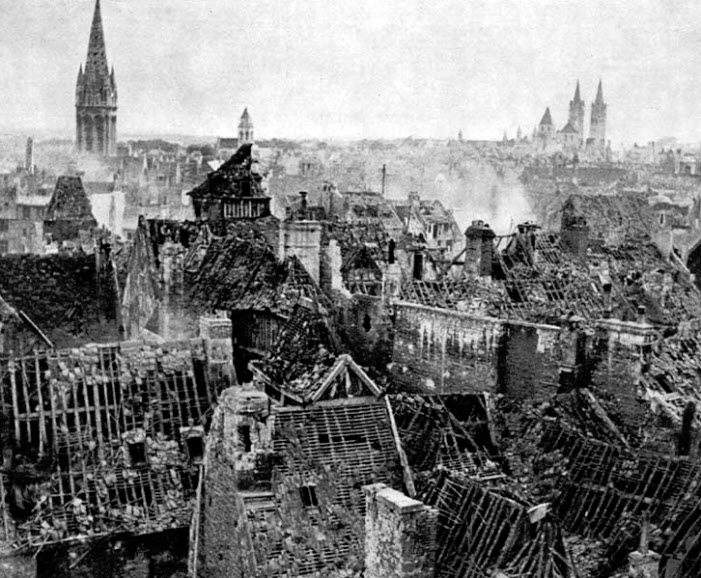
Leonard Oldroyd was born in Ossett on the 27th November 1917, the second son of two born to Wilfred Oldroyd (born 13th May 1881) and Louisa Adey (born 14th August 1881), who married at Holy Trinity Church, Ossett on the 23rd December 1911. Wilfred was 30 years old, and a widower, whose first wife, Clarissa Illingworth, died in spring 1908, aged 26 years; they had been married for less than a year.
At the time of his second marriage Wilfred worked as a G.N.R. railway goods clerk, and lived at his widowed father’s home at 23, Prospect Road, Ossett. Louisa was also 30 years of age, and was living at 63, Station Road, Ossett. Leonard had two brothers: Norman, born 1914 and Stanley, born 1915.
In September 1939, Wilfred and Louisa Oldroyd were living at 10, Sunnydale Crescent, Ossett with their two sons, Stanley and Leonard. Wilfred was a railway clerk, while Stanley worked as a wages clerk in a textile mill and Leonard was an insurance agent. Leonard Oldroyd married Doris May Wilby (born 1916), daughter of Ossett coal merchant Benton Wilby, in Ossett, in late 1939.
Following Leonard’s tragic death Doris Oldroyd remarried in Ossett in early, 1948 to Richard Grace.
It is likely that Leonard Oldroyd died during the Allied attempts to capture the French city of Caen that was heavily defended by battle-hardened German troops. Operation Goodwood took place between the 18th and 20th July 1944 as part of the battle for Caen when the British VIII Corps, with three armoured divisions, attacked to seize the German-held Bourguébus Ridge and the area between Bretteville-sur-Laize and Vimont and to inflict as much attrition on the German defenders as possible.
Operation Goodwood is called by some historians as ‘the largest tank battle in British Army’s history’. British forces deployed two infantry divisions and three armored divisions with 1,100 tanks. The Germans engaged with four infantry divisions, three armored divisions, two heavy tank battalions with 377 tanks. The British forces wanted to take control of Caen in Northwestern France to break through the German lines and liberate the rest of the occupied country. The British forces advanced seven miles to the eastern part of the city, but the Germans prevented a total breakthrough. The British had 3,474 casualties and lost 314 tanks. The Germans had unknown number of casualties but over 2,500 German soldiers were captured and they had lost 75 to 100 tanks in the battle.

Above: Infantry and Sherman tanks wait to advance at the start of Operation ‘Goodwood’, 18th July 1944. A Sherman Firefly tank is shown in the foreground.
The “Ossett Observer” carried this short obituary for Leonard Oldroyd:1
“Death From Wounds In Normandy – Lance-Sergeant L. Oldroyd, Ossett – Information was received yesterday that Lance-Sergeant Leonard Oldroyd (27), Royal Corps of Signals, son of Mr. and Mrs. Wilfred Oldroyd, Sunnydale, Ossett has died of wounds received in the Caen Sector, Normandy. A native of Ossett, he was educated at Batley Grammar School and was afterwards employed by the Pearl Assurance Company of Ossett. He joined up shortly after the outbreak of war and was in the fighting with the 8th Army at El Alamein, Tobruk, Sicily and Italy, and after three months’ leave went to Normandy on D-Day. Two other brothers are serving, and, prior to the El Alamein battle, he met one of them in Cairo.
He was a member of The Green Congregational Church and Institute, and of the institute table tennis team when at the peak of its success, and was also a member of the old Wesleyan Tennis Club at Sunnydale. He married Miss D.M. Wilby, now of West Wells Crescent, a daughter of Mr. Benton Wilby, coal merchant, Ossett. He is a nephew of Mr. G.A. Oldroyd, deputy borough treasurer.”
Leonard Oldroyd died on the 23rd July 1944, aged 27 years, and is buried at grave reference IV. B. 5. in La Delivrande War Cemetery, Calvados France. Douvres-la-Delivrande is a village 14 kilometres north of Caen.
The Allied offensive in north-western Europe began with the Normandy landings of 6 June 1944. The burials in La Delivrande War Cemetery mainly date from the 6th June and the landings on Sword beach, particularly Oboe and Peter sectors. Others were brought in later from the battlefields between the coast and Caen.
There are now 944 Commonwealth servicemen of the Second World War buried or commemorated in this cemetery. 65 of the burials are unidentified but there are special memorials to a number of casualties known to be buried among them. The cemetery also contains 180 German graves.2

Above: Caen in ruined state after Allied bombing, July 1944.
References:
1. “Ossett Observer”, Saturday, July 29th, 1944.